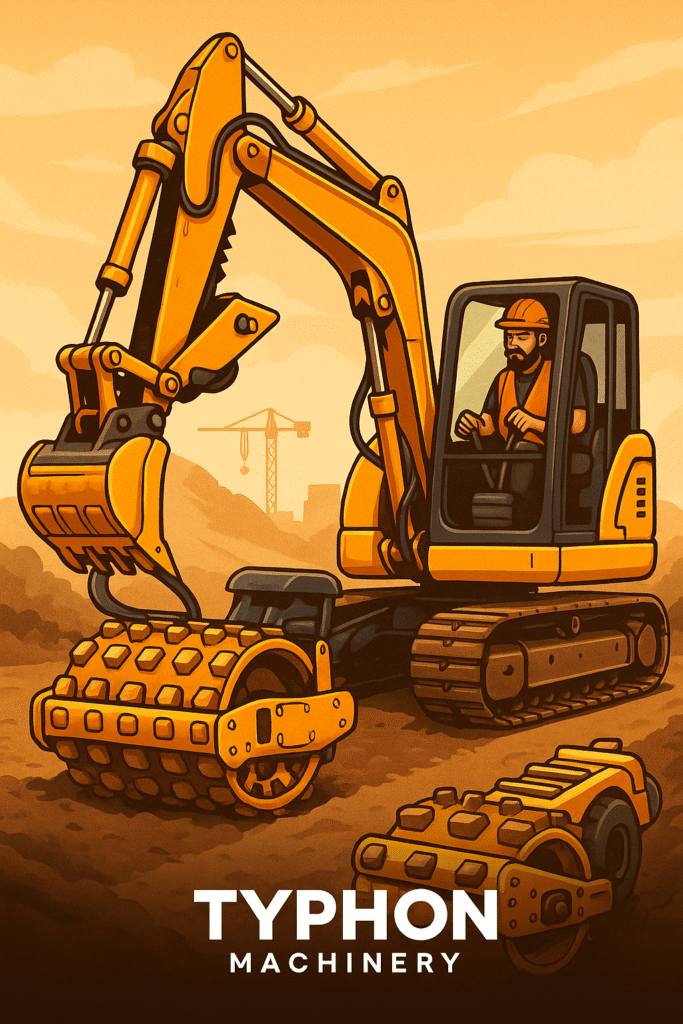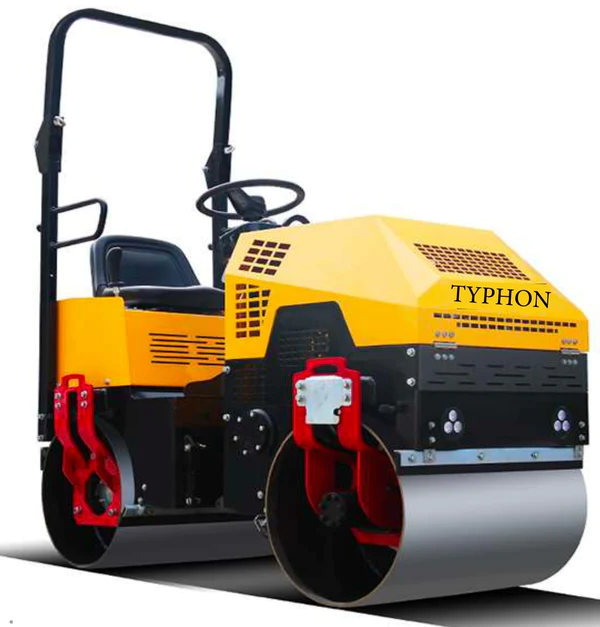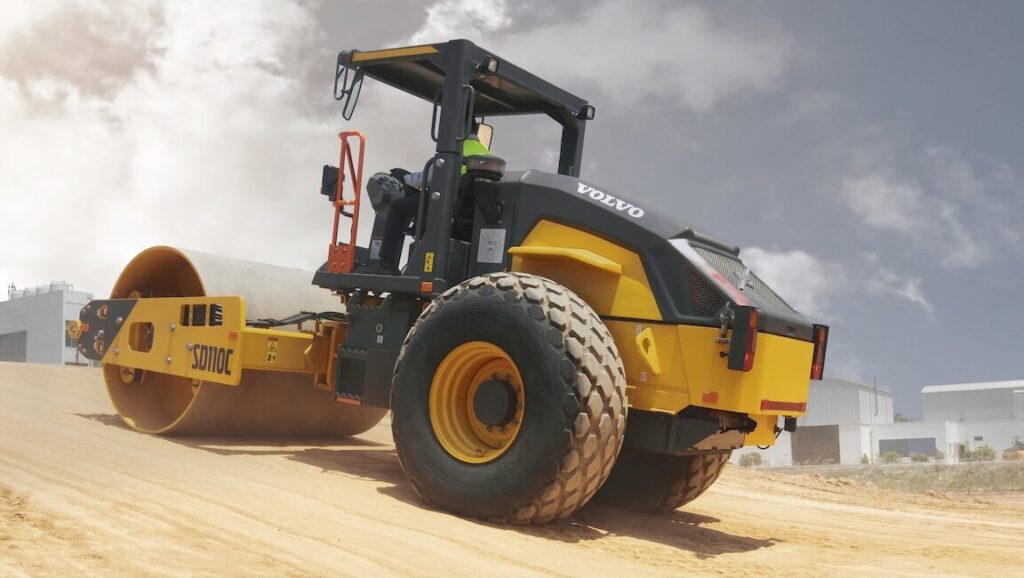Why Every Excavator Operator Needs a High-Quality Roller Compactor
In the construction industry, excavators provide an enormous contribution by taking charge of tasks such as digging, trenching, and material handling with remarkable efficiency. However, it is more than a mere machine.
To completely unleash the potential of road and earth moving projects, it is highly recommended that each and every excavator operator thinks over the idea of buying a top-quality roller compactor attachment.
The article tells us about the reasons why roller compactors are more than just an optional extra but are instead the absolutely must-have machines that play a critical role in the improvement of safety, and in the enhancement of the efficiency of the whole project. We will go through their efficiency levels, check the other machines, find the needed characteristics to look for, and then give the answers to some of the questions that arise.
Understanding the Role of a Roller Compactor Attachment
A roller compactor attachment is a specific tool that is tailor-made for working together with an excavator. Once installed, it enables the operator to complete tasks of soil and surface compaction without the need for a different, heavy machine. The operation of a compactor includes applying force and frequency of the vibration that, in the end, the soil, gravel, sand, or asphalt substances get denser.
Quite typically, there are smooth drum rollers, padfoot or sheepsfoot rollers for cohesive soils, vibratory rollers for deeper compaction, and grid rollers for coarse material. When they are joined to the boom of the excavator, these compactors are designed to be remote controlled and super-permissible in the operation cycle, with the operator being capable of compacting the surfaces even in areas that would be unapproachable or dangerous for the conventional machines to move into.
What Is a Roller Compactor Attachment?
A roller compactor attachment is a very unique tool that can be added to an arm or a boom of an excavator. It utilizes vibratory and static forces to compact soil, gravel, sand, and asphalt. The major categories are:The most suitable types to use include:
- Drum Rollers – They are further categorized as smooth drum and padfoot and used for different soil types.
- Vibratory Rollers – They are the appliances which are fitted with high-frequency vibration facilitating deep compaction.
- Grid Rollers – Types featured with large voids and used for coarse materials.
Even from a distance, these compaction equipment’s let the operator do the work with accuracy and impeccable efficiency. Often, these are places where traditional compactors can’t reach.
Why Excavator Operators Should Use a Roller Compactor
Improved Efficiency and Workflow
One of the primary benefits of using a roller compactor attachment is the significant improvement in the workflow. The traditional methods usually have to do with scheduling and transporting a separate ride-on compactor, which brings about logistical complexities and waste of time. The implementation of a compactor on the same machine that is already carrying out excavation automatically means that there is no need for these inefficiencies anymore.
The capability to compact the material immediately after removing not only hastens the whole process and but also keeps continuous the work-from-operation especially where trenching, grading, and foundation preparation are concerned. This system is now playing the key role in decreasing rental demands of the required machinery, as well as in the doubling of productivity through the same number of the team in less time.
- Reduce the number of machines needed: Remodel your excavator into a compactor machine by using a compactor attachment.
- Reach difficult-to-access places: One can use the formats in the trenches, slopes, and keyholes for the work of compacting.
- Time saved: Fewer moving of machines and setting up times leads to the project being done quickly.
Versatility in Construction Tasks
Implementing a high-quality roller compactor on excavators results in flexible, multi-functional machines that can accomplish a wide array of tasks.
Apart from the traditional function of earthwork, the machines are now capable of compacting, a task which is often accomplished using a separate roller. Such applications mainly serve infrastructure developing and maintenance, i.e., road construction, commercial buildings, utilities, and landscaping.
Operators are allowed to work efficiently and with a greater degree of flexibility as they are able to switch back and forth between digging and compacting. Since they can be used not only for digging but also for compacting a newly dug trench for laying pipes or a new driveway, a rolled excavator becomes an all-around solution.
Roller compactors, besides excavating tasks, also have
- Compact the subgrade prior to the placement.
- Make the trench ready for piping.
- Even out and consolidate pavements, sidewalks, and trails.
These can be used for:
- The construction and reconstruction of streets and highways
- Bigger buildings and office spaces construction
- Redoing landscapes
- Underground facilities and pipeline projects
Cost Savings
While, on the one hand, the purchase of high-quality roller compactors requires a certain financial contribution initially, in the end, the ability of these units to significantly slash operational costs cannot be overestimated.
The use of a compactor alone, by replacing the multiple instruments with only one, for example, saves contractors money on rental fees, transport charges, and less demand for labor.
The compactors themselves, given that they are of excellent quality and are made by well-known manufacturers, usually require less frequent maintenance and are designed to be used in the rough job site environments.
At the same time, the constant use of an excavator-mounted compactor may enable the unqualified project budget to generate a lower cost implying the success of the undertaken activities from the start to their end without ignoring the central points of the accomplishment.
Secondly, though buying high-quality roller compactors comes with a price, these machines can easily return the investment many times over.
- Reduced labor: Fewer people are needed to manage separate machines.
- Lower equipment rental: One multi-use machine instead of two.
- Minimal downtime: Less maintenance compared to walk-behind or ride-on units.
Brighter Results in Terms of Quality
Compaction is a process that must be carefully carried out since it directly impacts the long-term durability and stability of the buildings. A poorly executed compaction can cause effects such as uneven surfaces, soil settlement, erosion, or even worse, collapse.
Through the consistent vibration, the soil’s uniform pressure distribution is ensured; a good-quality roller compactor attachment reaches deeper soil penetration. This is beneficial in producing a more compact and more structurally sound base that can neither move nor degrade easily.
The result is a more aesthetically pleasing finish, an increased load-bearing capacity, and fewer rewards for future repair works.
Poor compaction can lead to:
- Soil settlement
- Structural instability
- Water drainage issues
A high-quality roller compactor delivers:
- Consistent pressure and vibration
- Uniform compaction depth
- Less weak spots, reinforcing the long-term durability of roads and foundations.
Increased Operator Safety
Something that is very important on each and every job site is the safety of workers. The addition of roller compactor attachments helps in enhancing safety during operations significantly. The person in control of the compactor does it from inside the excavator’s cab and this means that there is no need for the operator to manually control the vibrating equipment nor work in areas that might be hazardous, such as, for example, deep embankments and narrow trenches. This eliminates the possibility of injuries and exposure to harmful vibration and noise. People who operate these machines are always safe within them, which means that any physical strain and fatigue will be minimal, resulting in more concentration and a better overall performance.
One great advantage of an excavator-mounted compactor is that it allows the operator to stay in the cab.
- No requirement of any person to manually control or walk beside the vibrating equipment.
- Keeping safe while operating in the embankments or trenches.
- Less exposure to noise and vibration fatigue.
Choosing the Right Roller Compactor
One of the essential key features in the selection of a roller compactor attachment is to determine if it is compatible with the excavator that you have. The attachment should be the right fit in terms of weight class, hydraulic output, and coupler type of your machine. In addition to this, you also have to take note of the materials used to build the attachment. Steel drums that are made of reinforced steel, corrosion-resistant finishes, and high-performance vibration systems should be considered.
Brands such as Caterpillar, Eterra, Typhon, Roller Comapctors, Stanley, and MBW are good examples of entities that only manufacture units that have been tested in the field and are known to be trustworthy. Furthermore, the ability to easily perform maintenance procedures is very important; the choice should be for products with service points that are easily accessible, and also with inspection processes that are clear so that the downtime is minimized. Moreover, the very best compactors with a high degree of versatility enable you to change the strength of the vibrations according to various soil types and also work demands.
Things to Look at in a Good Roller Compactor
Features to look for in such a machine include:
Compatibility
- Investigate alternate connection types.
- Ensure a proper match of the weight and flow requirements for the attachment.
Quality
- Reinforced steel drums
- Resistance to corrosion
- Subsystem capacity
Vibration
- Power Controlled
- changes to vibration frequency
Maintenance and Service
- Grease points with no difficulty
- A small number of necessary spare parts
- Manufacturer’s offered service intervals
How to Get the Most Out of Your Roller Compactor
One of the ways to get the maximum return on your roller compactor purchase is operator training. A person’s understanding of the interaction between the soil and the compactor, as well as the settings of the vibrations, and the methods of compacting can have a significant impact on the results.
Regular maintenance practices, such as ensuring timely lubrication and regularly inspecting the attachment for wear, are necessary for the working of the equipment efficiently. The right type of compactor should also be used with the job in order to achieve the highest efficiency—suitable for padfoot rollers in sticky soils, smooth drum roller in granular materials, and vibrating roller compactor.
- Train your operators: One who has even operated excavators still need to follow the training standards for the best compaction result.
- Regular maintenance: Ensure that you follow the timetable for lubrication, examination, and repair.
- Match the tool to the job: Use padfoot rollers for clay; smooth drum rollers for granular materials.
- Monitor compaction quality: Employ GPS or soil sensors if and as necessary.
Real-World Example: Trench Compaction in Urban
Construction In one of the urban pipe-laying projects, the use of manual compactors was not only inefficient but also risky making the narrow trenches. Consequently, the nature of the compacting work was changed by connecting the attachment of a vibratory roller compactor making a labor saving of 40%, a time saving of 60%, and ensuring the construction of the slump. It was even more convenient as the operator was still in the excavator, thereby minimizing the potential risks of doing the work.
Conclusion
A high-quality roller compactor is a worthwhile business investment. A compact roller can be obtained by becoming smarter, faster, safer, and more durable and easy to use. This accessory works for road construction, utilities, and site preparation. It influences cost and ensures a proper job, thus it helps with work. Want to buy a roller compactor? If so, visit rollercompactor.net first. There are several trustworthy devices that have been inspected by professionals and will profit from their advise.
Heavy carriers need compactors that are easy to use, safe for operators, and efficient. The attachment’s quality demands soil compaction, and its technology is cutting-edge. The compactor can be turned into a multi-functional device for city infrastructure, highways, attractive landscapes, or foundations to ensure better outcomes and higher revenue.
Frequently Asked Questions (FAQs)
Can I use a roller compactor on any excavator?
Not every compactor is suitable for an excavator. The criteria need to be based on the unit’s weight, hydraulic flow, and attachment compatibility. See the equipment’s manual or ask your dealer for advice.
Is a vibratory compactor better than a static one?
Usually, the vibratory compactors are the more efficient ones when deeper compaction is required. In comparison, static rollers are considered as the adequate equipment for limited depth work and fine grading.
How often should I service a roller compactor?
The frequency of servicing is dependent on the manufacturer and therefore, there are different recommendations for maintenance. However, the majority advise a check for wear and tear after every 100–200 hours of work and a visual check of the compactor for leaks every shift as required.
Can I rent a roller compactor attachment?
Yeah, you can rent them at various heavy equipment rental stores. Temporary, non-repetitive projects are among the projects that are most feasible for hiring.
- What soil types are best compacted with a roller compactor?
- Granular soils (sand, gravel): Best with smooth drum rollers.
- Cohesive soils (clay, silt): Use padfoot or sheepsfoot rollers.
- Mixed soils: Choose vibratory rollers with variable frequency.





